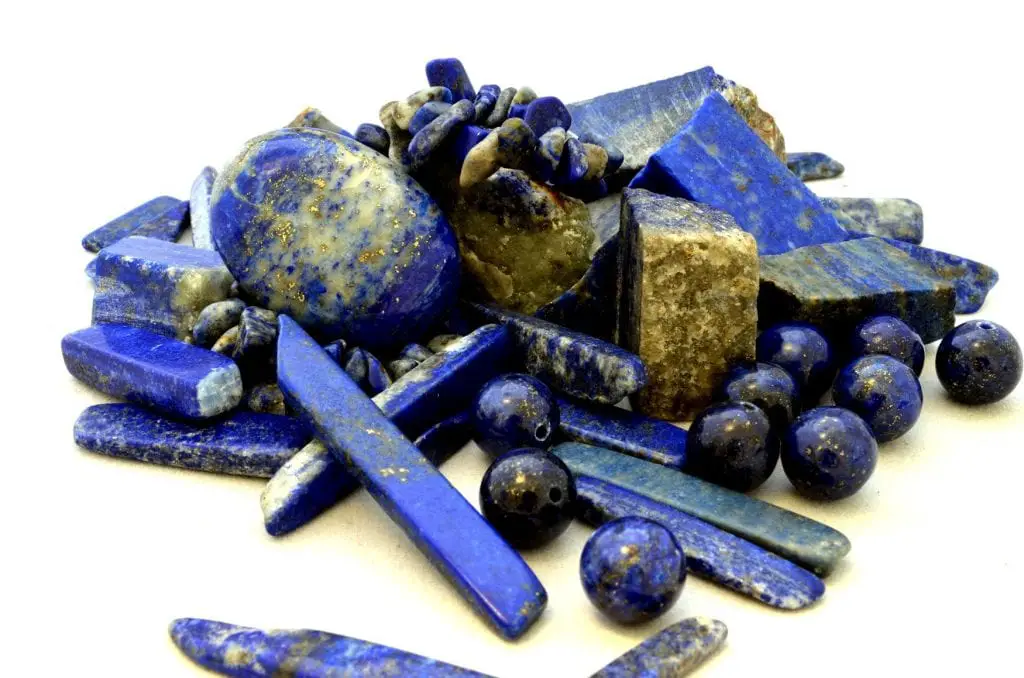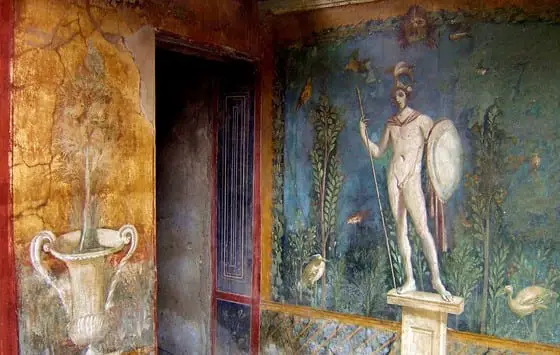Romans used the word ‘blue’ rather symbolically. To them, blue was an epithet used to describe one’s temper, character, and moral values. The color blue was also applied when portraying someone’s intellectual and political status. The literal use of the word ‘blue’ was nearly non-existent. This made scientists hypothesize that the people of the Ancient World were color-blind to blue.
On the other hand, there is plenty of evidence that the Ancient Romans used blue in their everyday life. Ancient Romans made blue dye from woad (Isatis tinctoria) and several other plants. According to Vitruvius (a Roman author from the fist century BC), the founder of the Roman blue dye industry (caeruleo colore) was Vestorius of Puteoli, a rich Roman citizen in Alexandria. He produced a blue dye by heating up a paste made of ground sulfur, copper and sand. The common people of Rome obtained a cheap version of blue dye from violets, woad, whortleberries and other simple ingredients.
Blue, the color of the sky and deep waters in Ancient Rome
There are two Latin terms that evoke the color blue as it is seen in the nature — caelum (sky) and caeruleus (deep sea or storm-clouds). Consequently, the Ancient Romans often spoke of two different types of blue — caesis and caerulis. Caesis (light gray-blue color) was only used to describe attributes of gods, heroes and celestial animals. Caerulis (deep blue, sea-blue) was generally reserved for the enemies and for the less-respectable men.

Blue-eyed gods, heroes and mythical animals
Two Roman gods were directly associated with the archetype of the blue sky — Caelus and Jupiter. Caelus (from the Latin word caelum, meaning ‘sky’ or ‘heavens’) was the primal god of the sky, and Jupiter’s father. Jupiter, the chief Roman god, was the god of sky and thunder.
In Ancient Rome men, gods and divine creatures of pale or gray-blue eyes were considered admirable. The Latin poet Catullus spoke of a mystical blue-eyed lion from the Libyan mountains. Nero, the fifth Roman emperor, was described by historians as a man of dim blue eyes (oculis caesis et hebetioribus). The expression oculis caesis was used as a metaphor by many Roman writers to describe a few other Roman Emperors, including Jovian and Valentinian.
Through the epithet of dim blue eyes, two other Roman gods were linked to the blue symbolism of Ancient Rome — Sol Invictus and Neptune. Sol Invictus, the Roman god of the sun (also known as Helios in Greek mythology) is often represented in paintings and mosaics with blond curly hair and blue eyes. Neptune (Poseidon’s counterpart in Greek mythology), the god of freshwater and the sea, is typically depicted with bright-blue eyes. The horses of Pluto, the ruler of the dead, have been described by Ovid as ‘sky-colored’ ones.
Two Roman goddesses are also linked to the color blue. Minerva, the Roman goddess of crafts and war, has been described as a goddess of caesios oculos, dim blue eyes. Venus, the Roman goddess of beauty, love and fertility was naturally associated with the color blue, since she was born from the foam of the blue sea.
The Romans and the Greeks share a sorrowful story of Cyane or Kyane (‘dark blue’ in Greek). Cyane was a freshwater nymph who tried to save her friend Proserpina from the advances of Pluto. Failing in her efforts, she gets grief-stricken and melts into a pool made of her own tears. Kyanite, a deep-blue mineral, owes its name to the legend of Cyane.
Blue as a symbol of wickedness
In the blue symbolism of Ancient Rome, blue eyes were not always indicative of royalty and divine blessings. The Roman Emperor Galba had blue eyes, but his were of different shade — oculis caerulis, the color of the sea.
According to the Roman theory of physiognomy, such blue eyes were not flattering. They belonged to a man ‘remote from women, remote from blessings, and very desirous in hoarding money’ . Galba had a reputation of a cruel and ruthless Emperor who was assassinated within seven months into his reign.
In Ancient Rome, sea-blue eyes were also attributed to immoral women and inferior intelligence men. Interestingly, though, blue was also seen a symbol of female beauty, when used in cosmetics. Namely, the women in Ancient Rome used blue eyeshadow to color and accentuate their eyes. The shade of blue in their make-up palette was derived from the copper mineral azurite.
Blue as a symbol of primitivity, barbarism and hostility
Ancient Romans stereotyped ‘yellow haired, blue-eyed’ German tribes as uncivilized, and often mocked their phenological traits. The blue they referred to was caerulis, the color of the deep sea. This animosity was a result of the ‘unity in hostility’ demonstrated by the German tribes towards the Roman Empire.
After conquering the British tribes, Julius Caesar spoke of them as terrible-looking warriors, covered in blue war paint (sea-blue shade). The tribes whom he vilified in his testimonial were the Picts (Celtic-speaking peoples). The Picts were known for painting and tattooing their bodies with a blue dye obtained from woad plant pigments.
Romans learned from Greek writers that men in India colored their clothes, beards and hair in blue, green, and other exotic colors. Romans found these customs to be unusual and unacceptable.
Some historians believe that this negative connotation given to the color blue was a result of the geographical unavailability of blue dyes on the territory of the early Roman civilization. Ancient Rome imported lapis lazuli, azurite, blue pigments and indigo from distant lands (Egypt, India, modern-day Iran and Afghanistan). In all likelihood, this trade has associated the color blue with the East and with the ‘barbarians’ from those faraway territories.

Blue clothes as symbol of ordinariness, poor taste and mediocrity
In Ancient Rome, the type of blue color worn by a person was a strong social and status marker.
Public servants wore blue-color uniforms. This was considered a cheap, utilitarian and unimpressive color, easily made from the woad plant. The affluent individuals wore indigo-colored robes. The dye was imported from India and costed a fortune. Philosophers also wore such indigo-blue robes.
Juvenal, a Roman poet from the end of the first and the beginning of the second century AD, wrote about simple, dark-blue cloaks, known under the name venetus, and worn by commoners. He also ridiculed men who wore blue checks clothing, and considered them effeminate.
Roman blue symbolism in sports and competitions
In the area of sports, Romans greatly enjoyed watching chariot races in the Circus Maximus (chariot-racing stadium) in Rome. The Roman Emperor Nero built several amphitheaters in which chariot races could be watched. The amphitheaters were covered with sky-blue ‘vela’ (canopy), spangled with stars. The color of this canopy was called colors caeli, meaning ‘that of the sky’.
There were four chariot teams: Blue, Red, White and Green. The Blues (venetus) and the Greens (prasinus) were known as great rivals. The word for blue, venetus, denoted the most vibrant shade of blue known by the Romans. The members of the Blue Team wore durable venetus garments.
Vitellius, a Roman Emperor known for his indulgent gluttony and extravagant lifestyle, was a passionate supporter of the Blue Team. It is recorded that he had even killed several commoners, only because they openly criticized the Blue chariot team. The Blue Team almost always lost to the Green Team. This way, in the symbolism of the sport games of Ancient Rome, blue became associated with failure.
Tertullian, an early Christian author from the Roman province of Africa, was firmly against the chariot races. He considered these games a display of pagan elements and fiercely criticized them. He associated each chariot team to a different pagan force. According to him, the symbolism of the Blue Team was that of the Sky and the Sea, and the season of Autumn.
Villa Romana del Casale in The Sicily, home to one of the largest collection of Roman mosaics in the world, contains the famous mosaic piece called ‘Coronation of the Winner’. This artwork displays sportswomen competing in several disciplines, including ball-games. They are throwing around a four-colored ball, a quarter of which is blue. This art detail indicates that blue was often considered an important color during sport competitions in Ancient Rome.

Blue as a color of Roman art
An inferior version of ultramarine, Lazuline Blue, was used in the art and architecture of Ancient Rome. The restoration work on the Rome Colosseum revealed frescoes, walls, pillars and ceilings painted in several colors, including blue. Invisible traces of blue pigment have also been identified on a marble statue from the ancient period of Rome.
While many artifacts from Ancient Rome have lost their color, two archeological sites have managed to preserve plenty of colorful objects — Pompeii and Herculaneum. Archeologists have successfully restored ancient mosaics that feature colorful motifs bordered with pieces of vibrant blue glass.



